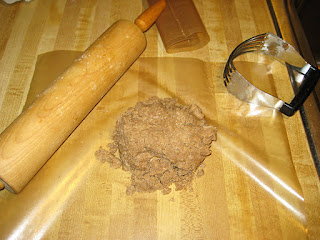My favorite holiday pie has always been a filbert pie (aka hazelnut) recipe that my mom was given by a friend who grew filberts in the Willamette Valley. When I had my first Thanksgiving dinner with my husband's family, I made my family's favorite filbert pie. Every year since then, my extended family has said that I'm not allowed to attend Thanksgiving dinner unless I bring a filbert pie.
I also offered to bake a pumpkin pie this year. In October, I made a pumpkin pie with a pie pumpkin. This time I wanted to use the butternut squash from our
Open Oak Farm CSA to see how the flavors compared. I used a sweet potato pie recipe from
The Fannie Farmer Cookbook, which I chose for the simple reason that it used regular milk rather than condensed or evaporated. I thought the original recipe was a little bland, so this time I increased the amount of nutmeg and cinnamon and added in ginger and cloves too.
On Tuesday before Thanksgiving I set out to make both of these pies in one afternoon with help from my 4-year old and lots of breaks to take care of my 4-month old. We managed to get both made over a 4-hour time span!
We started out making two 9-inch pie crusts with a simple salad oil crust recipe. This was the first time that I've tried to make this recipe completely with whole wheat flour. Sifting was essential, but the crust was very crumbly. The nice part about using the salad oil is that the crust is easy to put back together even if it crumbles.
Salad Oil Pie Crust
(makes 2 9-inch pie crusts)
3 c sifted flour (red wheat flour from our summer CSA)
1/2 t salt
3/4 c salad oil
6 T milk or water
Mix flour and salt. Add liquids and stir quickly with a fork or pastry cutter. Add few additional drops of liquid as needed.
Form dough into two balls and roll between sheets of wax paper. Transfer to pie dish.
After both pie crusts were finished, we began working on the fillings.
Filbert Pie
3 eggs
1/2 c brown sugar
1 c corn syrup
1/4 t salt
1 t vanilla
1/2 c melted butter
To toast filberts, spread shelled filberts in a single layer in a shallow pan. Toast at 275 F for 20 minutes. Use "skinned" or "unskinned." To remove skins, rub nuts between hands or with a rough cloth when cool. Store in an air tight container, freezer, or refrigerator. For the pie, chop coarsely and set aside.
Beat together eggs, sugar, syrup, salt and vanilla in a large bowl. Melt and slowly add butter to above mixture so as to not curdle the eggs. Stir in filberts. Pour mixture into a 9" pie shell.
Bake 375 F for 30-45 minutes until set in the center. Cool. Serve in very small servings because it is very rich.
And on to the squash pie.
Butternut Squash Pie
2 cups mashed cooked squash (Butternut from CSA)
2 eggs
1 1/4 c milk
3/4 c sugar
1/2 t salt
1 t cinnamon
1 t nutmeg
1/2 t ginger
1/2 t cloves
4 T butter melted
Preheat oven to 425F. Cook squash. I put the whole uncut butternut squash in the oven and cooked it for a little over an hour at 350F. After it cooled I scraped out the seeds into the compost and put the flesh into the refrigerator. It was a little chunky (unlike the pumpkin filling from a can), so I put the squash, milk, and eggs in my food processor until the mixture was smooth and frothy. Transfer to mixer and add in remaining ingredients. Pour into 9-inch pie pan.
Bake 10 min at 425F. Turn temperature down to 300F and bake for an additional 50 minutes or until a test knife comes out clean.
My helper really enjoyed licking the pumpkin pie beater. He proclaimed that it was, "Really, really good." I think the pies look nice too. I'm looking forward to testing them on Thursday!






























 Corn Flour Waffles
Corn Flour Waffles






 Cabbage Gratin
Cabbage Gratin





